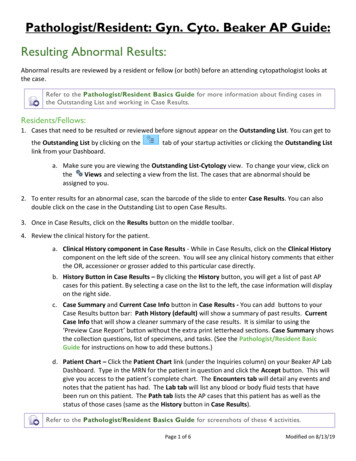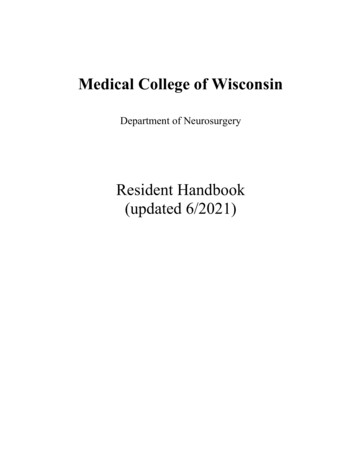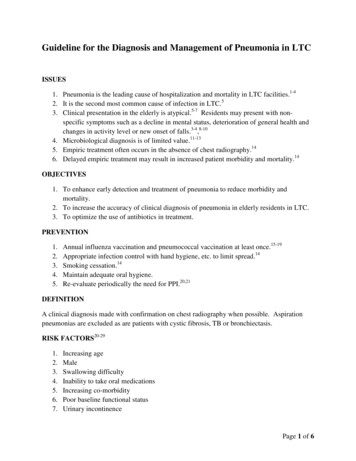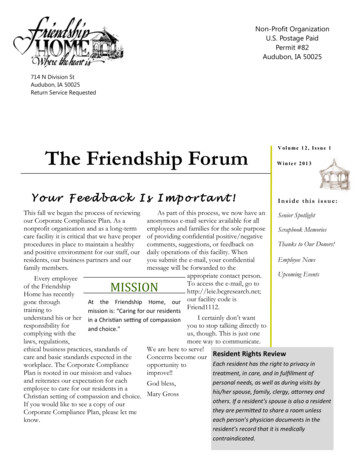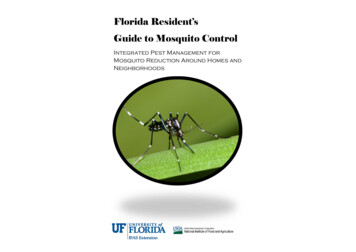
Transcription
Florida Resident’sGuide to Mosquito ControlIntegrated Pest Management forMosquito Reduction Around Homes andNeighborhoods
Florida Resident’s Guide to Mosquito ControlIntegrated Pest Management for Mosquito ReductionAround Homes and Neighborhoods2014C. R. Connelly1, E. Bolles2, D. Culbert3, J. DeValerio4, M. Donahoe5, K. Gabel6, R. Jordi7, J. McLaughlin8, A. Neal9, S. Scalera10, E. Toro11, and J. Walter10.University of FloridaInstitute of Food and Agricultural Sciences1FloridaMedical Entomology Laboratory Research and Education Center,Vero Beach, FL 329622EscambiaCounty Extension, Cantonment, FL 325333OkeechobeeCounty Extension, Okeechobee, FL 349724Bradford5Santa8Miami-DadeCounty Extension, Starke, FL 32091Rosa County Extension, Milton, FL 325706MonroeCounty Extension, Key West, FL 330407NassauCounty Extension, Callahan, FL 32011Extension, Department of Regulatory and Economic Resources,Miami-Dade County, Miami, FL 330309St.Lucie County Extension, Fort Pierce, FL 3498110Brevard11SuwanneeCounty Extension, Cocoa, FL 32926County Extension, Live Oak, FL 32064Funding for this document was provided by USDA-NIFA.Cover photo: Aedes albopictus, the Asian tiger mosquito, bySean McCann, UF/IFAS/FMEL.2
Integrated Pest Management forMosquito Reduction Around Homes andNeighborhoodsHomeowners who actively participate in reducingmosquitoes around the home can help decreasepesticide use, reduce the risk of contracting mosquito-borne diseases, and help ease the financial burden tolocal governments who are responsible for area-widecontrol. Modern mosquito control for the homeownerhas to be an integrated pest management (IPM)program, utilizing a combination of methods thatemphasizes source reduction - eliminating areaswhere mosquitoes thrive whenever possible.Surveillance for mosquitoes is required prior to theapplication of any insecticide to determine whether ornot an application is necessary. Deterring certainmosquitoes can be accomplished by individualsthrough the use of screening, sanitation, and othertechniques described in this document. The methodsrecommended in this publication are particularlyeffective in reducing mosquitoes that transmitdiseases. Ultimately, homeowners who takeresponsibility for identifying and eliminating sourcesof mosquito production around their homes andneighborhoods will advance the health and quality oflife for all Florida residents.3
Mosquito Control Organizationsin FloridaMany Florida counties have mosquito control programs thatare funded by local taxes. The first organized mosquito controldistrict was established by the Florida Legislature in 1925 inIndian River County. St. Lucie County Mosquito ControlDistrict was formed in 1926. There are now over 50 suchprograms of varying sizes throughout Florida.Florida map, circa 1825. Note the region on the east coast named“Musquito County” Map courtesy: Special Collections Department,University of South Florida.4
The Mosquito ControlSection of the FloridaDepartment of Agricultureand Consumer Services(FDACS), Bureau ofEntomology and PestControl, administersmosquito controlprograms under theauthority of the MosquitoControl Act, Chapter 388Florida postcard vintage 1930s.of the Florida Statutes andChapter 5E-13 of the Florida Administrative Code. A directory ofmosquito control programs can be viewed at the FDACS websitewww.freshfromflorida.comThe Florida Coordinating Council on Mosquito Control advises theCommissioner of Agriculture on mosquito controlissues. The Council meets three times a year andone of the mandates of the Council is to assistFDACS in resolving disputes arising over thecontrol of arthropods on publicly owned lands.The Florida Mosquito Control Association is a nonprofit group with a mission to promote effectiveand environmentally sound control of diseasetransmitting and pestiferous mosquitoes and otherarthropods of public health importance, developand enhance public interest, awareness, andsupport for the control of mosquitoes, and providefor the scientific advancement of members throughmeetings, training and education.www.floridamosquito.orgMosquito meter at the entrance to Collier-SeminoleState Park. Photo: Jeff Stivers, Collier MosquitoControl District5
History of Mosquitoes inFlorida1500sThe word “mosquito” first enters the English language. In a 1583publication “Hakluyt’s Voyages” M. Phillips writes of being annoyed by akind of fly which the Spaniards called “Musketas.” Jesuit missionary writesfrom a settlement near Miami where he endured several months of swarmsof bloodsucking mosquitoes which prevented him from sleeping manynights.1600sAfter being shipwrecked, Jonathan Dickinson documents in his journalwhen the party encounters an “abundance ofmosquitoes hindered our rest, to remedy whichwe digged holes in the sand, got some grass andlaid it therein to lie upon, in order to coverourselves from the flies ” It provided littlecomfort. Portion of Florida’s east coast labeled“Barra de Mosquitos” by mapmakers.Historic marker in area where the Reformationwas shipwrecked in 1696. A Florida StatePark is named in honor of Jonathan Dickinson.Photo: Palm Beach Post.1700sYellow Fever epidemics in North Americaincluding Florida. Dengue epidemics inFlorida.1800sMajor yellow fever epidemics in CedarKey, Jacksonville, Key West, Pensacola,St. Marks, and Tampa. Malaria commonin Florida. Joseph Y. Porter appointedfirst state health officer and leads a lifelong campaign to wipe out yellow feverand malaria in Florida.(Top) Leaving food at the house of a family infected with yellow fevervirus. (Bottom) Shotgun yellow fever quarantine in Florida,1888. Image:U. S. National Library of Medicine, History of Medicine Division6
1900sMalaria Control in War Areas (MCWA)established around military bases in thesouthern US where malaria was still present.Last cases of Yellow Fever in Florida. FloridaAnti-Mosquito Association formed. Firstmosquito control districts formed in Indian Riverand St. Lucie counties. Aedes albopictus, theAsian tiger mosquito discovered in Florida.Photo: Archives of Florida, FloridaMemory, http://floridamemory.com/2000sOutbreaks of St. Louisencephalitis and eastern equineencephalitis. West Nile virusfound for first time in Florida inJefferson County. Over 50mosquito control agenciesestablished in Florida. Floridaexperiences outbreaks of denguefor first time in over 70 years.Chikungunya diagnosed inFlorida residents.This historic image depicts three publichealth personnel carrying out tasks involvedin Malaria Control in War Areas (MCWA)projects. Photo courtesy: CDC/K. LordFirst Meeting, Florida Anti-Mosquito Association, Daytona Beach, Florida. Dec. 1922. Written on back: Dr. Stewart Thompson, Col Turck, Dr.McDonald Col Porter, Geo W. Simons, Harry Osborn. Photo: George W.Simons, Jr. Planning Collection, Thomas G. Carpenter Library, Universityof North Florida, Jacksonville, Florida7
MosquitoesMosquitoes are two-wingedflies that live in humid tropicsand subtropics, warm moistclimates, temperate and coolzones - everywhere exceptareas that are permanentlyfrozen. Globally, there areabout 3,500 species ofmosquitoes, and 80A flooded salt marsh, a common source ofspecies occur in Florida.mosquitoes in coastal Florida. Photo: PeterConnelly, AMVAC, Inc.A mosquito larva. Photo: JamesNewman, UF/IFAS/FMELAdult mosquitoes inside a mosquitotrap. Photo: James Newman, UF/IFAS/FMELFloodwater mosquitoes feeding on humanblood. Photo: Alan G. Curtis, Indian RiverMosquito Control District8
Mosquito Life CycleMosquitoes develop through 4 different forms during their life: Egg,larva, pupa, and adult.Eggs are generally one of two major types: floodwater or permanentwater. Floodwater eggs are laid on damp soil and surfaces, not onstanding water and while they need water to hatch, they must dryout first. Permanent water eggs are laid on the water surface and donot survive if they dry out.During the larval stage, as the larvae grow, they shed their skin(molt) four times and each stage is called an instar. Larvae developinto pupae are active swimmers, but they do not eat anythingduring the short time they are in this stage. The larval and pupalstages of the mosquito are aquatic; the adult is terrestrial. Adultmosquitoes are able to fly after their wings dry out.Permanent water egg raft. Photo:Sean McCann, UF/IFAS/FMEL.Floodwater eggs. Photo: RoxanneConnelly, UF/IFAS/FMEL.1st through 4th instar larvae (left toright). Photo: Roxanne Connelly,UF/IFAS/FMEL.Mosquito pupa. JamesNewman, UF/IFAS/FMEL.Male mosquito (left), female mosquito (right).Photo: Roxanne Connelly, UF/IFAS/FMEL.9
Mosquito EggsEgg raft containing over 200 eggs.The actual size of this entire egg raftis about the same as a grain of rice.Photo: Roxanne Connelly, UF/IFAS/FMELThe type of egg and how it isdeposited varies among thedifferent species of mosquitoes.Eggs are generally oblong, tapering at the top end androunded at the bottom end.Some mosquito species haveeggs with floats on the side,and some eggs are covered withsmall bumps. These details ofthe egg can be seen with theaid of a microscope.Mosquito eggs are white whenthey are first laid, but darkenafter a few hours as the outerlayer hardens.Eggs with floats, present onAnopheles species of mosquitoes.The actual size of each egg is justa bit smaller than a grain ofground pepper. Photo: RoxanneConnelly, UF/IFAS/FMELEggs that are deposited on thewater surface, called permanent water eggs, cannot withstand drying out and usuallyhatch within a day or two. Eggsthat are deposited on a moistsubstrate, called floodwatereggs, require a period of dryingout, and then will hatch whencovered with water.Mosquito eggs vary in size depending on the species, butmost are smaller than a grainof ground pepper.Floodwater eggs. Photo: RoxanneConnelly, UF/IFAS/FMEL10
Mosquito LarvaeMosquito larvae live in thewater and come to thesurface to breathe withtheir breathing “siphon”.One type of mosquito,Anopheles, does not havesiphons and breathe atthe water surface throughopenings called “spiracles”located on the abdomen.Anopheles larva at water surface. Photo:James Newman, UF/IFAS/FMELOut of water, mosquitolarvae will not survive. Asthey grow, they shed theirskin, or molt, four times before they transform into pupae.Each stage is called an instar. Larvae feed on organic matterand living organisms by filtering water through their mouthparts.Mosquito larvae are called “wrigglers” because of the way theyswim through the water, using an s-shaped motion. The larval stage can last from several days to several months depending on the water temperature and the mosquito species.Towards the end of the 4th instar,larvae stop feeding and prepare forthe next stage of life as a pupa.1st—4th instar larvae (left to right).Photo: Roxanne Connelly,UF/IFAS/FMELLarva with a long breathing siphon. Photo:George O’Meara, UF/IFAS/FMEL11
Mosquito PupaePupae are aquatic and will not survivefor long out of water. Pupae have tocome to the water surface to breathethrough their “trumpets” (twoappendages that allow them to take inoxygen).The developing adult can be seenthrough the skin of the pupa. Pupaecannot feed because the mouthparts areinside the pupal skin and are notfunctional during this life stage.Mosquito pupae are called “tumblers”because of the way they appear todive down and tumble through thewater when disturbed. Generally, thepupal stage lasts about two to threedays.Mosquito pupa. Photo: JamesNewman UF/IFAS/FMELEmerging AdultAdult mosquito emergingfrom the pupal case.Photo: James NewmanUF/IFAS/FMELAt the end of the pupal stage, the combined head and thoraxsplits open and the adult mosquito crawls out onto the watersurface. The wings must dry and harden before the mosquitocan fly. It takes about four minutes for the adult to emerge.During this time, if the water is disturbed enough, the mosquitocan fall over and be trapped in the water and die.12
Adult MosquitoFemale Culex quinquefasciatus ,Southern House Mosquito, obtaining ablood meal from a human. Photo: James Newman UF/IFAS/FMEL13
What domosquitoes eat?LarvaeMosquito larvae can eat algae, bacteria, copepods (smallcrustaceans), yeast, other organic matter andmicroorganisms in the water. Some species can eat othermosquito larvae.PupaeMosquito pupae do not have functional mouthparts, sothey do not feed during this life stage. They survive thisstage by using remaining energy reserves from the larvalstage.Adults - male and femaleBoth male and female mosquitoes feed onnectar to obtain sugar as an energy sourcefor flying. Nectar sources include flowers,injured plants, honeydew (excreted byother insects while they feed on plant sap),and fruit juices.Adult femaleFloodwater mosquitoes covering theFemale mosquitoes need blood tolegs of a mosquito biologist. There arenourish their developing eggs.times in Florida when the mosquitoesSome species can develop theircan be this bad! Photo: Alan Curtis,first batch of eggs without a bloodIndian River Mosquito Control.meal. Thesource of blood for femalemosquitoes varies depending onhost availability and mosquitospecies.Mosquitoes feeding on a southern toad.Photo: Erik Blosser, UF/IFAS/FMEL14
Does anything eatmosquitoes?Like other living organisms, mosquitoes are eaten by otherorganisms that are known as predators. While there are noorganisms that are known to feed exclusively onmosquitoes, many animals will feed on them.Fish, copepods (small crustaceans), dragonfly anddamselfly nymphs, and frogs will eat mosquito larvae.Frogs, dragonfly and damselfly adults, birds, and bats willeat adult mosquitoes.It is never a good idea to rely solely on natural predators toprotect yourself from mosquito-borne diseases as thepredators are not able toconsume every livingmosquito. All it takes isone probe from an infectedfemale mosquito to infect ahuman.Northern cardinal. Photo:Roxanne Connelly, UF/IFAS/FMELDamselfly. Photo: Tyler Jones, UF/IFAS15
Female mosquito bloodfeedingFemale mosquitoes are attracted to carbon dioxide. Humansand other animals exhale carbon dioxide with every breath.After locating and landing on an attractive host, themosquito probes the skin with her mouthparts (known as aproboscis) to find a capillary in the skin. She pierces the skinwith her serrated proboscis, not really biting, but suckingblood. She injects a pain killer, present in her saliva, whichmakes the piercing less noticeable. Her saliva also contains ablood thinner so that the blood will flow into her, rather thanclot. If her salivary glands are infected with a pathogen, itmay be transmitted to the host when she takes the bloodmeal.The volume of blood one female can ingest depends on hersize. Generally, mosquitoes take in about five microliters ofblood. How much is that? When blood is donated, thetypical amount taken is a pint. It would take 94,600 of thefive microliter bites to get a pint of blood!Aedes aegypti female with a full blood meal in herabdomen. Photo: James Newman, UF/IFAS/FMEL.16
Mosquito FlightMosquitoes fly to mate, find blood sources, escape predators,lay eggs, and to find resting places. The frequency of themosquito wing beat ranges from 300 – 600 beats per second.Males and females of the same species recognize each otherby listening to wing beat frequency.Flight activity is reduced at temperatures around 60 F, andmosquitoes are inactive at 50 F and lower.How far a mosquito flies from the aquatic habitats varies withspecies. Some go only 500 feet from where they emerged;some move dozens of miles from the larval habitat.Mosquito wings are coveredwith scales and hairs. Photos:(left) Roxanne Connelly, UF/IFAS/FMEL; (right) Michele Cutwa,UF/IFAS/FMEL.17
Mosquito HabitatsAll mosquitoes require water for the eggs to hatch, and forthe larvae and pupae to grow. Different mosquito speciesprefer different types of water for laying eggs andcompleting their aquatic stages of life.The three major types of aquatic habitats are permanent,floodwater, and containers. Permanent water habitatsremain wet most of the time, floodwater habitats aretransient and can change quickly depending on weatherconditions. Container habitats can be natural, such astree holes and bromeliad plants, or human-made includingbottles, tires, buckets, and more.Flooded salt marsh. The dark areas in the water are millions ofAedes taeniorhynchus (salt marsh mosquito) larvae. Photo: TreyEnglish ADAPCO, Inc.18
Permanent water habitatsCattails. Photo: UF/IFASRiver backwaters. Photo: UF/IFASFloodwater habitatsDrying salt marsh mud. Photos:Peter Connelly, AMVAC, Inc.Dairy lagoon. Photo: RoxanneConnelly, UF/IFAS/FMELContainer habitatsTires holding water. Photo: JamesNewman, UF/IFAS/FMELWheelbarrow holding water. Photo:James Newman, UF/IFAS/FMELBromeliad plants (left) andbird bath (right).Photos: Roxanne Connelly,UF/IFAS/FMEL19
Floridians need to befamiliar with these fivemosquitoes.There are 80 different species of mosquitoes known to occurin Florida. Some are pests; some transmit pathogens thatcause disease. Here are a few that feed on humans:Photo: James Newman, UF/IFAS/FMELScientific name: Aedes aegyptiCommon name:Yellow fever mosquitoLarvae are found in water-holdingobjects found around the home andyard such as flower vases, tires,toys, bottles, conch shells, cans,refrigerator drain pans, barrels,bromeliad plants, and othercontainers.Found in all Florida counties.Vector of dengue andchikungunya viruses.Scientific name: Aedes albopictusCommon name:Asian tiger mosquitoLarvae found in water-holdingobjects found around the homeand yard such as flower vases,tires, toys, bottles, cans, barrels,tree holes, bromeliad plants, andother containers. Found in allFlorida counties, but does notoccur in the Florida Keys.Vector of dengue andchikungunya viruses.Photo: Sean McCann, UF/IFAS/FMEL20
Scientific name:Culex nigripalpusLarvae are found in ditches,containers, grassy pools, dairylagoons, furrows in citrus groves.Found in all Florida counties,abundant throughout the state.Photo: James Newman, UF/IFAS/FMELVector of dog heartworm, St.Louis encephalitis virus, WestNile Virus.Scientific name:Aedes taeniorhynchusLarvae are found in saltmarshes. Found in allFlorida counties, strongfliers. Major pests duringsummer and early fall.Vector of dog heartworm.Photo: James Newman, UF/IFAS/FMELScientific name:Psorophora ciliataLarvae are found in ditches,containers, grassy pools,furrows of citrus groves,pasture areas. Found in allFlorida counties, abundantthroughout the state.Not known to vector anymosquito-borne pathogens.Photo: Sean McCann, UF/IFAS/FMEL21
DiseasesSeveral of the mosquito species that inhabit Florida are capableof transmitting pathogens that sometimes cause disease inhumans, horses, and some companion animals like dogs andcats. The following is a list of mosquito-borne diseases that havebeen detected in Florida:ChikungunyaAffects humans. No vaccine.DengueAffects humans. No vaccine.Dog heartwormAffects dogs and cats.Preventatives available from veterinarians.Eastern equine encephalitisAffects humans, horses, and some exotic birds.Vaccine is available for horses.St. Louis encephalitisAffects humans. No vaccine.West Nile fever and West Nile encephalitisAffects humans and horses.Vaccine available for horses.For more information on the mosquito-borne diseases thataffect humans, visit http://www.cdc.gov/ncidod/diseases/list mosquitoborne.htm or http://www.floridahealth.gov/.22
What’s attractive tomosquitoes?A female mosquito seeking blood to nourish her eggs isprimarily attracted to carbon dioxide. When humans exhale,carbon dioxide is released.After feeding on blood, the female mosquito needs to find aresting spot while her body digests the blood, this can takeup to three days. She looks for dark, shady, well protectedareas to rest to avoid being eaten and to stay warm andhumid.Both male and female mosquitoeswill look for places to rest inbetween the times they arefeeding and mating. They look fordark, moist, protected areas andcan be found around wet bags,dark corners inside barns or onporches, around damp mops andother wet items, and in densevegetation.Vegetated areas around homes are whereWhen the femaleadult mosquitoes like to rest. Photo:mosquito has digestedRoxanne Connelly, UF/IFAS/FMELa blood meal and isready to lay eggs, she is attracted to various water sources.Some mosquito species are very picky about where they laytheir eggs and will search until they find the perfect watersource for their tastes.23
How to repelmosquitoesThe U.S. Centers for Disease Control and Prevention (CDC)recommends the use of certain products containing activeingredients which have been registered by the U.S.Environmental Protection Agency (EPA) for use as repellentsapplied to skin and clothing. EPA registration of repellentactive ingredients indicates the materials have been reviewedand approved for efficacy and human safety when appliedaccording to the instructions on the label.CDC evaluation of information contained in peer-reviewedscientific literature and data available from EPA has identifiedseveral EPA registered products that provide repellent activitysufficient to help people avoid the bites of disease carryingmosquitoes. Products containing these active ingredientstypically provide reasonably long-lasting protection:DEET (Chemical Name: N,N-diethyl-m-toluamide or N,Ndiethyl-3-methyl-benzamide)Picaridin (KBR 3023, Chemical Name: 2-(2-hydroxyethyl)-1piperidinecarboxylic acid 1-methylpropyl ester )Oil of Lemon Eucalyptus* or PMD (Chemical Name: paraMenthane-3,8-diol) the synthesized version of oil of lemoneucalyptusIR3535 (Chemical Name: 3-[N-Butyl-N-acetyl]-aminopropionicacid, ethyl ester)*Note: This recommendation refers to EPA-registered repellentproducts containing the active ingredient oil of lemon eucalyptus (orPMD). “Pure” oil of lemon eucalyptus (e.g. essential oil) has notreceived similar validated testing for safety and efficacy, is notregistered with EPA as an insect repellent, and is not covered by thisCDC recommendation.24
In general, higher concentrations of an active ingredientprovide longer duration of protection, regardless of the activeingredient. Note that concentrations above 50% do not offera marked increase in protection time. Products with 10%active ingredient may offer only limited protection, often fromone to two hours. Products that offer sustained release orcontrolled release (micro-encapsulated) formulations, evenwith lower active ingredient concentrations, may providelonger protection times. Regardless of what product you use, ifyou start to get mosquito bites reapply the repellent accordingto the label instructions or remove yourself from the area withbiting insects if possible.Repellents for use on clothing:Certain products containing permethrin are recommended foruse on clothing, shoes, bed nets, and camping gear, andare registered with EPA for this use. Permethrin is highlyeffective as an insecticide and as a repellent. Permethrintreated clothing repels and kills ticks, mosquitoes, and otherarthropods and retains this effect after repeated laundering.The permethrin insecticide should be reapplied following thelabel instructions. Some commercial products are availablepretreated with permethrin.Application of mosquito repellent. Photo: Centers for DiseaseControl http://www.cdc.gov/media/dpk/2014/dpk-whd.html25
EPA recommends the following precautions when using insectrepellents:Apply repellents only to exposed skin and/or clothing (as directed on theproduct label.) Do not use repellents under clothing.Never use repellents over cuts, wounds or irritated skin.Do not apply to eyes or mouth, and apply sparingly around ears. Whenusing sprays, do not spray directly on face—spray on hands first andthen apply to face.Do not allow children to handle the product. When using on children,apply to your own hands first and then use the material on your handsto apply it to the child. You may not want to apply materials to children’shands to avoid the chance they could transfer the materials to the eyesand mouth.Use just enough repellent to cover exposed skin and/or clothing. Heavyapplication and saturation are generally unnecessary for effectiveness. Ifbiting insects do not respond to a thin film of repellent, apply a bit more.After returning indoors, promptly wash treated skin with soap and water.This is particularly important when repellents are used repeatedly duringthe day or on consecutive days. Also, wash treated clothing beforewearing it again. (This precaution may vary with different repellents—check the product label.)If you or your child gets a rash or other reaction from an insect repellent,stop using the repellent, wash the repellent off with mild soap and water,and call a local poison control center for further guidance. If you go to adoctor because of the repellent, take the repellent with you to show thedoctor.Note that the label for products containing oil of lemon eucalyptusspecifies that they should not to be used on children under the ageof three years. Other than those listed above, EPA does not recommendany additional precautions for using registered repellents on children oron pregnant or lactating women.For additional information regarding the use of repellent onchildren, please see CDC’s Frequently Asked Questions aboutRepellent Use. t repellent.htm]26
The University of Florida’s Florida Medical Entomology Laboratoryhas tested and published the results on the efficacy of the followingrepellents. Average Complete Protection Time is the time thatelapses between the proper application of a repellent until the firstmosquito lands on the protected area. 60 minutes protection timeMosquito feeding on arm of individualusing a repellent bracelet, demonstratingthe ineffectiveness of the bracelet. Photo:Roxanne Connelly, UF/IFAS/FMEL27
How to reduce mosquitoesThere are many gimmicks for sale that do not work, so be aneducated consumer and don’t waste your money on impulse buys!The tips listed here do work to reduce mosquitoes.Source Reduction is the most important technique that homeownerscan employ to reduce mosquitoes. Since mosquitoes need water tolive, removing water sources around the home goes a long way toprevent mosquitoes from occurring. When water is intentionally collected for use, such as in rainbarrels, the water holder should be modified to preventmosquitoes from laying eggs on or near the water. Add screeningto the top to prevent mosquitoes from laying eggs, or cover therain barrel with a lid. For water not intentionally collected, such as water that collectsin discarded cans, bottles, and buckets, it is best to properlydispose of water holding containers or empty the water from thecontainers. In Florida, it is best to flush out containers such as bird baths,and bromeliad plants, every three to four days during thesummer. Take used tires to a local facility that will accept them. Dispose of old appliances that are sitting outdoors. Clean out the roof gutters to remove leaves that may clog thedrain and cause water to be retained. Check for and repair leaky faucets. Check for standing water in your yard, areas that may pool andremain after rainfall events. Make sure these areas can drainwell. Or add Bti to kill the mosquito larvae (see page 34 for moreinformation).28
Water gardens and ornamental ponds are popular, butaerate them or stock with fish to reduce mosquitopopulations. See page 30 for more information on fish. Repair torn window and door screens to exclude mosquitoesfrom indoors. Clean up vegetation that has fallen from trees. Areca palmfronds, for example, hold water when they are on theground. For homes with windows that don’t have screens, usemosquito netting around the bed to prevent mosquitoes frombiting while residents are sleeping. Fans can be used to keep mosquitoes away. Mosquitoes areweak flyers. Operating a fan on high will help keep flyingmosquitoes out of the area. Organize community efforts to help everyone locate andremove sources of water where mosquitoes can live. If yourneighbors are not reducing mosquitoes, you are still at riskfor mosquito bites.Some items that are not effective for reducingmosquitoes:Mosquito plantsBug zappersConsumption of garlic, vitamin B, andbananasRepellent bracelets and wristbandsUltrasonic devices and cell phone appsDragonfly mimics29
Predators of MosquitoLarvaeFISHFor ornamental ponds, aquatic plant nurseries, abandonedswimming pools, and sources of standing water that areintentionally placed for a specific use (feeding wildlife,rainwater for gardens, etc.), the addition of some smallnative fish can help to keep the mosquito larvae populationto a minimum.Fish native to Florida that can be used for mosquito controlinclude (* game fish)Eastern Mudminnow (Umbra pygmaea)Pygmy Killifish (Leptolucania ommata)Lined Topminnow (Fundulus lineolatus)Golden Topminnow (Fundulus chrysotus)Sailfin Molly (Poecilia latipinna)Eastern Mosquitofish (Gambusia holbrooki)Least Killifish (Heterandria formosa)Banded Pygmy Sunfish (Elassoma zonatum)Everglades Pygmy Sunfish (Elassoma evergladei)Bluespotted Sunfish (Enneacanthus gloriosus)*Flier (Centrarchus macropterus)*Spotted Sunfish/Stumpknocker (Lepomis punctatus)*Bluegill or Bream (Lepomis macrochirus)*Redear Sunfish or Shellcracker (Lepomis microlophus)30
Most of these fish can befound in local watersources such as ditchesand canals. If they arenot game fish*, they canSailfin Molly. Poecilia latipinna. Photo:be collected with a net,USGSminnow trap, or barblesshook. Hook and line needto be used for game fish (see page 30 for list of game fish),and there are limits for game fish; check with Florida Fishand Wildlife Conservation Commission on the limits.http://myfwc.com/Check with your local mosquitocontrol agency because in someFlorida counties, the mosquitocontrol prog
Vero Beach, FL 32962 2Escambia County Extension, Cantonment, FL 32533 3Okeechobee County Extension, Okeechobee, FL 34972 . mosquito control districts formed in Indian River and St. Lucie counties. Aedes albopictus, the Asian tiger mosquito discovered in Florida. 2000s






